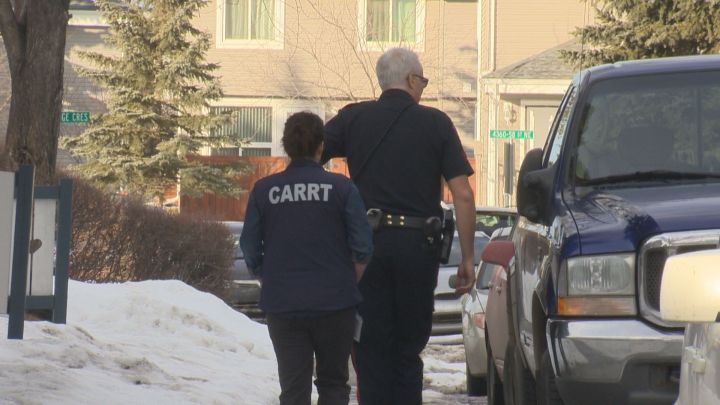Picture a home where a baby is crawling on the floor, but the floor is covered with animal feces. On the counter, a baby bottle sits beside a drug dealer’s supply of cocaine–measured out and ready to sell.

This is a typical case for the Child at Risk Response Team (CARRT), which operates out of the Sheldon Kennedy Child Advocacy Centre (SKCAC) in Calgary.
CARRT is called to investigate when a child is at immediate risk. The team is made up of a police officer and an assessor from Child and Family Services; Cst. Dan Allen and Roxanne Demaere make up one team.
“It’s not necessarily always that something has happened to a child, although we will investigate those, there are times where we’re going to try and prevent on that harm,” Allen said.
He describes a typical scenario: a child discloses information to a teacher.
“Something physical’s happened in the home, or drug activity, or criminal activity that could bring harm into the home and to the child. There’s times we are dealing with domestic violence and perhaps the domestic violence is the risk factor.”

Get weekly health news
CARRT will go to the school and interview the child before they go home–and if necessary–keep them from returning to a potentially harmful environment.
“Our first priority is generally assessing the safety of a child,” Demaere explained. “Substance abuse concerns, neglect, abuse, discipline, really anything that’s going to place a child at risk.”
- Calgary taxi driver hailed as hero after baby born in back seat
- Environment Minister Rebecca Schulz quits cabinet, to leave soon as Alberta MLA
- Another ‘catastrophic’ water main break prompts usage limits for Calgary region
- Attempted kidnapping near Banff Christmas Market prompts police investigation
READ MORE: Hope, help and healing part III – ‘I can take care of my son by myself’ – mom credits AVIRT program
Sgt. Colleen Bowers oversees the CARRT, and says it’s rewarding and disturbing all at once because the victims are children.
“I can’t stop anything that’s happened to them, but I can try to stop it from happening again,” Bowers said.
The ultimate goal is to keep families together whenever possible, but they always put the needs of the child first.
One of the most common issues CARRT investigates is discipline, specifically excessive discipline.
Allen described one case in which a child was bound and beaten after school staff told parents the child wasn’t paying attention in class that particular day.
“We start to discover what he’s actually fearful of is going home because of the potential he’s going to be tied up. He doesn’t only have fresh injuries, but injuries over months.”
Investigations could lead to criminal charges as well as education or counselling.
“If the home environment in that moment isn’t suitable for the child or safe or hygienic for the child to be in, a solution can be: can we go stay at grandma or grandpa’s or an aunt or uncle’s just for the night so the family can clean up the home with support and have the kids back the next day? Is it a more complicated problem? Do we need to have somebody come in to support to make sure that home is cleaned and maintained in that way? Those are all determinations that we’re making at that time,” Demaere explained.
READ MORE: Hope, help, and healing part II – POST helps high-risk women prep for motherhood
Every case always comes back to what’s best for the child.
“Nobody out there is hoping the CARRT team shows up at their doorstep in a day. It’s probably a pretty rough day when you have a police officer and social worker in your home talking with you about what is probably your most precious thing: your children,” Allen said.
There are four CARRT teams operating out of the SKCAC. Between the four teams, they handle upwards of 150 cases per month.
Watch below: Hope, help and healing parts I to III










Comments